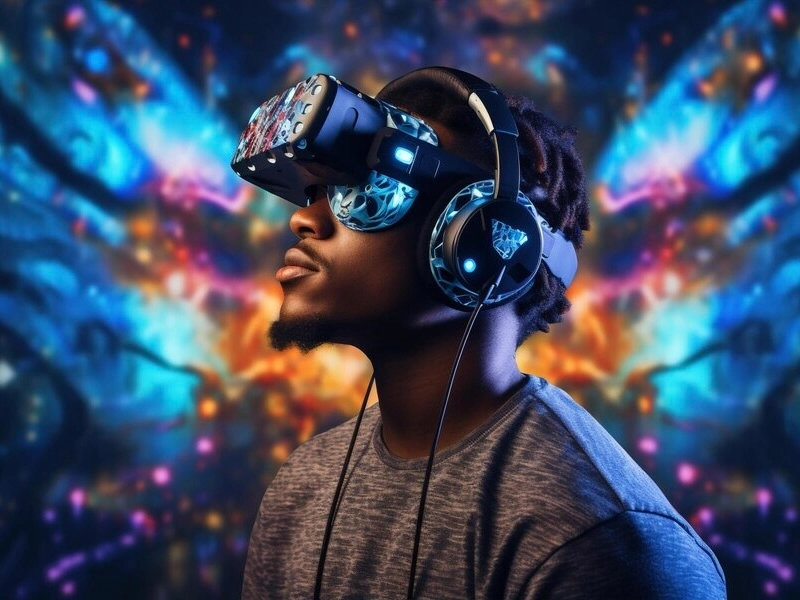- Virtual reality (VR) technology enables users to interact with artificial three-dimensional (3-D) visual or sensory environments, creating immersive experiences that simulate reality.
- VR applications utilise interactive devices like goggles, headsets, gloves, or body suits to transport users into digital realms where they can explore, interact, and manipulate their surroundings.
- There are various types of VR, including non-immersive, semi-immersive, and immersive VR, each offering different levels of immersion and interaction with the digital environment.
Virtual reality (VR) technology enables users to engage with artificial three-dimensional (3-D) visual or sensory environments, creating an immersive experience that simulates reality. Utilising interactive devices like goggles, headsets, gloves, or body suits, VR applications transport users into digital realms where they can explore, interact, and manipulate their surroundings.
what is VR technology?
Virtual reality (VR) refers to the utilisation of computer-generated models and simulations that enable individuals to engage with an artificial three-dimensional (3-D) visual or other sensory environment. VR applications immerse users in computer-generated environments that replicate reality, facilitated by interactive devices such as goggles, headsets, gloves, or body suits. In a typical VR setup, a user dons a helmet equipped with a stereoscopic screen, through which they view animated images of a simulated environment. This illusion of “being there” (telepresence) is achieved through motion sensors that track the user’s movements and adjust the screen view accordingly, often in real-time. Consequently, users can explore simulated spaces, with their viewpoints and perspectives dynamically changing based on their own head movements and steps. Moreover, by wearing data gloves equipped with force-feedback devices, users can experience the sensation of touch and manipulate virtual objects within the environment.
The term “virtual reality” was coined in 1987 by Jaron Lanier, whose contributions to research and engineering significantly influenced the early VR industry. Early VR research and technology development in the United States were notably shaped by the federal government’s involvement, particularly agencies like the Department of Defense, the National Science Foundation, and NASA. Projects funded by these agencies, conducted at university-based research laboratories, fostered a pool of skilled personnel in areas such as computer graphics, simulation, and networked environments. These initiatives also established crucial connections between academic, military, and commercial efforts.
Also read: Apple’s Vision Pro headset: Global expansion and advanced VR features
Different types of VR
Non-immersive VR: Non-immersive VR provides minimal interaction with the digital environment, often involving a computer screen or projection system to display a 3D environment without complete immersion. Examples include video games and driving simulators used in training schools.
Semi-immersive VR: Semi-immersive VR overlays digital components onto real objects, allowing virtual elements to be interacted with similarly to real objects. This makes semi-immersive VR ideal for educational purposes, such as pilot training or technical skill development.
Immersive VR: Fully immersive VR transports users entirely into a virtual environment, with no fixed point of reference to the real world during use. Typically found in the gaming industry, immersive VR employs special equipment like data glasses, gloves, treadmills, or sensory detectors to create an entirely realistic digital environment. Users perceive the virtual world as real, blurring the lines between virtual and physical reality.
AR: Augmented reality (AR) is a form of VR that overlays digital content onto the real world. Unlike fully immersive VR, AR integrates virtual elements into the user’s physical environment, enhancing real-world experiences with digital information. A common example is the use of smart glasses in industries like warehousing, where employees can access real-time data overlays.
MR: Mixed reality (MR) combines elements of both physical and virtual worlds, creating a seamless blend of real and digital content. A specialised form of augmented reality, MR is increasingly utilised in marketing applications, allowing for the visualisation of people or objects within real-world contexts.
Also read: AR vs VR: What’s the difference?
Components of VR
Headset: The VR headset is a pivotal wearable device that allows users to immerse themselves in digital environments by replacing their natural field of view with a computer-generated display. Integrated with features like infrared LEDs, motion sensors, cameras, and screens, the headset gathers relevant information and presents it to the user’s eyes.
Screens and lenses: Screens and lenses work together to ensure that the VR experience is as realistic as possible. By distorting and overlapping two nearly identical images, screens and lenses create the desired spatial effect, enhancing the immersion factor of the virtual environment.
Latency: Latency, along with the field of view, is crucial for providing users with an authentic experience in both real and virtual environments. The perception of distance and spatial depth is influenced by latency and field of view. Modern VR headsets aim to replicate human vision within a visible range of 200 to 220 degrees, subdivided into monocular and binocular visual fields.
Frame rate: Maintaining an optimal frame rate is essential for preventing motion sickness and ensuring a smooth VR experience. While the human eye can capture around 1,000 images per second, modern VR headsets typically target a frame rate of 90 frames per second (FPS). This balance ensures that visual information is transmitted efficiently without overwhelming the user.
Position tracking: Position tracking enables users to move freely within the virtual environment, enhancing their sense of presence and interaction. Systems like 6 degrees of freedom (6DoF) allow users to move in various directions and perform common gestures, such as nodding, leaning, and rotating. In contrast, 3 degrees of freedom (3DoF) systems restrict movement to basic head movements, limiting the user’s spatial interaction.

